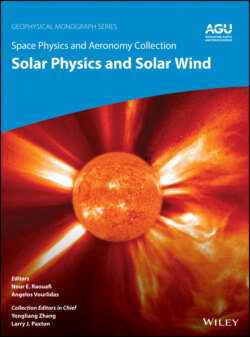Читать книгу Space Physics and Aeronomy, Solar Physics and Solar Wind - Группа авторов - Страница 11
Оглавление
PREFACE
The upcoming decade will mark a turning point in solar and heliospheric research. The spacecraft fleet comprising the Heliophysics Systems Observatory will be augmented by a set of unique space missions and ground‐based telescopes that will greatly expand our knowledge of the heliosphere. The Parker Solar Probe (PSP) was launched in August 2018, sixty years after it was conceived as humanity’s first mission to enter and study a stellar atmosphere from “within.” The PSP will approach closer to the Sun than any spacecraft before to explore the solar atmosphere as close as 8.86 solar radii above the surface. The PSP has completed 6 of its 24 scheduled orbits as of this writing. The data recorded during the first six orbits show an unprecedented view of the nascent solar wind. We expect more discoveries as the spacecraft flies ever closer to the Sun. The Solar Orbiter (SolO), launched in February 2020, will approach within 60 solar radii but from an orbit inclined by up to 34° out of the ecliptic. SolO will give us the first unprojected images of the solar poles and measure the magnetic fields in these regions. The largest ground‐based telescope ever built, the 4‐m Daniel K. Inouye Solar Telescope (DKIST), will be operational next year. The DKIST will reveal solar structures as small as 20–30 km in diameter. In the near future, the 4‐m European Solar Telescope (EST) will also become operational.
The observations and measurements from the PSP and SolO and those we will get from the DKIST, EST, and other future missions and telescopes will not only help answer long‐standing scientific questions but also lead to significant discoveries and open new avenues for exploration. These measurement capabilities will write a new chapter of space and solar physics. So, it is a good time now to take a look at the status of the solar and heliospheric research. This book presents seven chapters that cover most aspects of solar and heliospheric physics.
Important technological inventions, along with essential advances in mathematics and physical theories made over the last few centuries, led to fundamental solar and astronomical discoveries. These discoveries created new puzzles that form the main pillars and axes of solar and heliospheric research. The invention of the telescope and the discovery of sunspots by Galileo in the 16th century represent a turning point in solar physics research. Soon after, the 11‐year solar cycle was revealed with its long‐ and short‐term variability. The observation of the strongest flare in recorded history by Carrington in 1858 was another important milestone and the building block for solar activity and space weather. The exact nature of these phenomena remained hidden until the discovery of solar magnetism by George Hale (1908). He stated in his The Astrophysical Journal paper: “The present paper describes an attempt to enter one of the new fields of research opened by this recent work with the spectroheliograph,” which is a testament to the fact that scientific advances go hand in hand with technology. In the next half‐ century, three major phenomena were discovered: the coronal heating problem, the solar wind and its acceleration, and coronal mass ejections. All of these phenomena are driven by the magnetic field, which is generated deep in the convection zone
The Sun remains the most observed and studied star in the Universe. Yet many of the processes that govern its behavior are not fully understood. The solar dynamo and convection, coronal heating, the acceleration of the solar wind, flares, coronal mass ejections, and solar energetic particles are all outstanding examples of challenging solar and heliospheric problems. Solar and heliospheric research has undergone a renaissance in the last decades. Since the advent of the Space Age, significant strides have been made in our understanding of the Sun along with breakthrough discoveries. Important advances in theory and computing power are keeping pace, allowing access to fundamental physical processes that are otherwise impossible to explore because of the complexity of the underlying theories. These advances have helped us better understand the challenges facing us when we try to comprehend how the Sun and its corona work and also what it takes to obtain the measurements needed to make progress. Figure I.1 is an illustration of the integrated ground–space–theory system, which is a prerequisite to overcoming the hurdles we were facing for decades.
Understanding the Sun is essential not only because we live in its extended atmosphere (i.e., the corona and the solar wind) but also because it is the only star we can study in detail. The knowledge we gain from observing the Sun and its environment provides insights into other worlds that may harbor life like our Earth.
This book provides an overview of solar physics and the advances made over the past few decades as well as the challenging problems that remain. The seven chapters cover the solar interior, the atmosphere, magnetism and radiation, plasma heating and acceleration, and solar activity. It is a comprehensive view of how our star works and what is needed to understand it better. We hope that this reference work will help researchers in other fields, young scientists, teachers, students, and the public to familiarize themselves with the status of the field as of 2019.
Nour E. Raouafi and Angelos Vourlidas Johns Hopkins University Applied Physics Laboratory USA
Figure I.1 Illustration of the complex solar environment and the recent observational and modeling advances that will lead to breakthrough insights into challenging phenomena that have been puzzling scientists for decades. Top left: Slice view showing the Sun at different wavelengths. Top right: The fleet of heliospheric space missions. Bottom left: Image of the 4‐m DKIST solar telescope. Bottom right: Simulation of the structure of the solar corona for the 2017 eclipse.
(Source: Reproduced with permission from Predictive Science Inc.)
